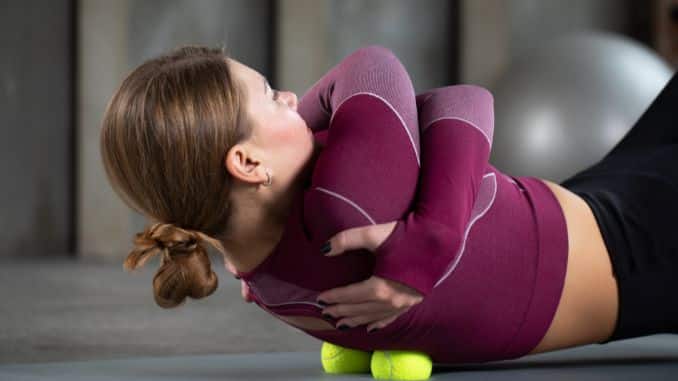
One doesn’t always need elaborate gym equipment to pursue fitness. Surprisingly, a simple tennis ball can be a versatile and cost-effective exercise tool. This article explores how tennis ball therapy can be a game-changer in your fitness routine, providing accessibility and effectiveness without breaking the bank. From enhancing core strength to facilitating myofascial release, the benefits of incorporating tennis balls into your workouts are both diverse and impactful.
Advantages Of Tennis Ball Therapy
1. Myofascial Release And Muscle Tension Relief
When engaging in self-massage using tennis balls, you can effectively target specific areas of muscle tissue, applying focused pressure to knots and trigger points. This targeted pressure induces a sensation often referred to as “good pain,” signifying the release of tension and the activation of the body’s natural healing response.
Incorporating tennis balls into your self-massage routine regularly, and I mean consistently, becomes a valuable tool for addressing tight muscles. These tennis ball exercises are not just about relieving pain; they’re about committing to your overall physical well-being. They promote improved flexibility and a more relaxed musculature; the more you do them, the more you’ll feel the benefits.
The controlled pressure applied through the tennis balls aids in myofascial release, allowing for an enhanced range of motion and increased comfort in daily activities.
Furthermore, instrument-assisted massage [²] to loosen muscles helps arrange the muscle fibers more neatly. This neat arrangement helps reduce knots and stickiness in the muscles.
This holistic approach to self-care becomes an essential component of maintaining optimal physical health and promoting a sense of relaxation and flexibility.
2. Core Strengthening And Stability Training
Integrating tennis balls into core workouts activates deeper abdominal muscle groups, introducing an element of instability that fosters increased strength and stability. The tennis ball is a versatile tool that targets specific muscle tissues within the core.
One major effect of a weak core is low back pain, a common issue that affects four out of five people in the U.S. at some time in their lives, causing a range of discomfort from mild to very painful. This unique approach strengthens the midsection and enhances overall core strength [⁴], contributing to a more robust and resilient core muscle group.
3. Balance And Proprioception Enhancement
The round nature of tennis balls makes them ideal for balance exercises, activating stabilizing muscles and improving proprioception. Myofascial Release Therapy [¹] correlates with improved balance control. Incorporating tennis balls into balance training contributes to an enhanced sense of body awareness and reduces the risk of injury in daily activities.
4. Foot Massage And Plantar Fasciitis Relief
Tennis ball massage effectively relieves foot tension, offering valuable relief for conditions such as plantar fasciitis. Rolling the feet over a tennis ball massages and stretches the plantar fascia, promoting circulation and reducing discomfort, making them a simple yet effective solution for addressing common foot issues.
5. Compact And Portable Fitness Solution
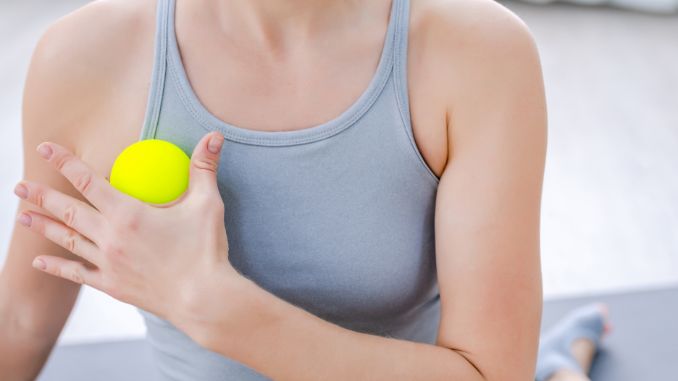
The compact size and lightweight nature of tennis balls make them an ideal fitness companion for on-the-go workouts. Easily fitting into a bag or desk drawer, tennis balls provide
- a convenient and accessible solution,
- ensuring individuals can seamlessly integrate them into various exercises,
- maintaining their fitness routine wherever they are.
Myofascial Release Exercises
The National Library of Medicine suggests that people suffering from Myofascial Pain Syndrome [³] should be educated about stretching exercises and ergonomic modification. Myofascial release exercises are techniques to alleviate tension and tightness in the myofascial tissues, which surround and support muscles throughout the body. These exercises aim to release myofascial restrictions and improve flexibility, function, and range of motion. Practitioners often use tools like foam rollers or balls and apply gentle, sustained pressure on the myofascial connective tissue to lessen the pain and restore motion.
1. Foot Rolling
Begin in an upright sitting position with your feet shoulder-width apart, maintaining good alignment with your head, shoulders, and hips. Step on the tennis ball with one foot and locate any trigger points, slowly rolling the ball from your heel to your toes and back. Try to move through each metatarsal, pushing as much body weight into the ball as is tolerable. It should feel slightly uncomfortable. Keep rolling back and forth and spend extra time moving through tight spots. Repeat the movement on the opposite side.
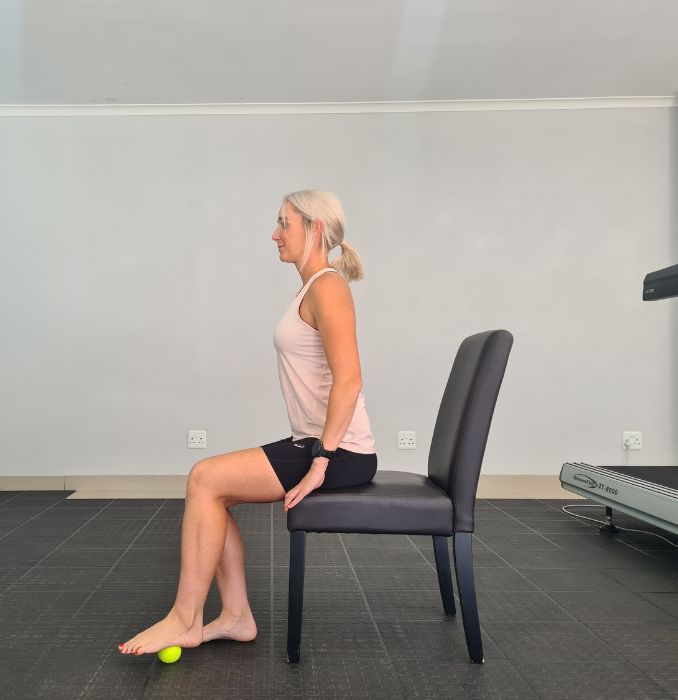
To counter-stretch, lift your leg and move your toes in a circular movement or from side to side before doing the next exercise,
2. Calf Rolling
Begin in an upright sitting position on the floor with your knees bent and feet flat on the floor, maintaining good alignment with your head, shoulders, and hips. Lean your upper back against the wall and place your hands at your sides for support if needed. Extend one leg in front and place the tennis ball under your lower calf area, locating any trigger points. Push from your hands to slightly lift your seat from the ground, then roll the ball from the top to the bottom of your lower calf area and back. Increase or decrease the pressure as needed. Repeat the movement on the opposite side.
Utilize a foam roller as an alternative to the tennis ball.
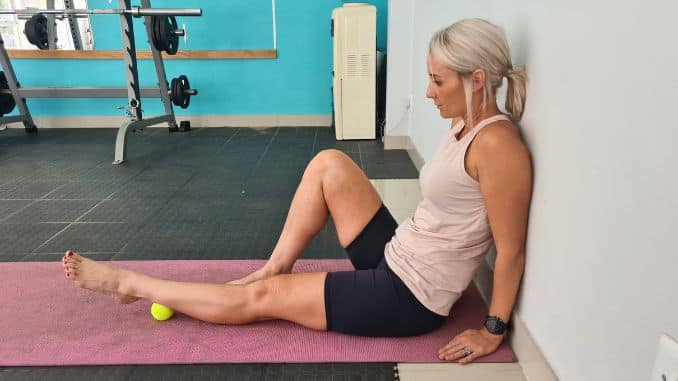 |
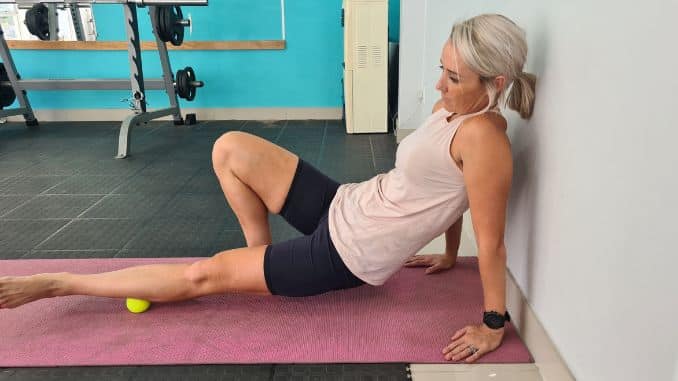 |
3. IT Band Rolling
Begin in an upright sitting position on the floor, maintaining good alignment with your head, shoulders, and hips. Move to one side as you straighten your bottom leg out. Cross your other leg over your bottom leg and flatten your foot on the floor, placing the tennis ball under your hip. Engage your core and slowly roll the ball from your hip, down to just above your knee and back. Relax and switch to the other side. Perform the movement for 10 repetitions on each side.
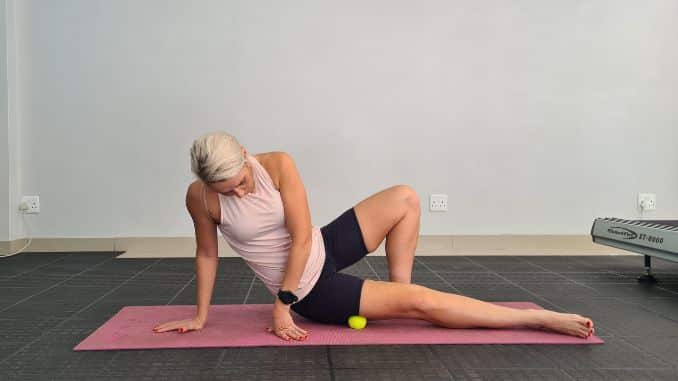
4. Snow Angels
Lie on your back on the floor with your knees bent and your feet flat on the floor. Place the foam roller vertically along your spine, with your head supported on one end of the roller and your seat on the opposite end of the roller. Maintain a good alignment with your head, shoulders, and hips as you keep your balance. Engage your core and slowly bring your arms overhead in wide arcs, similar to a snow angel movement. Lower your arms to return to the starting position and repeat the movement. Start with 1 set of 10 repetitions.
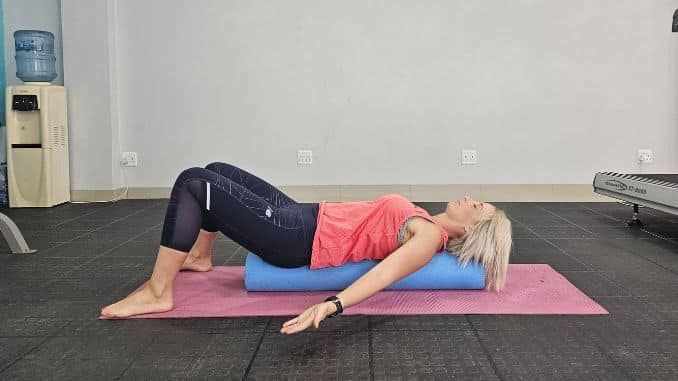 |
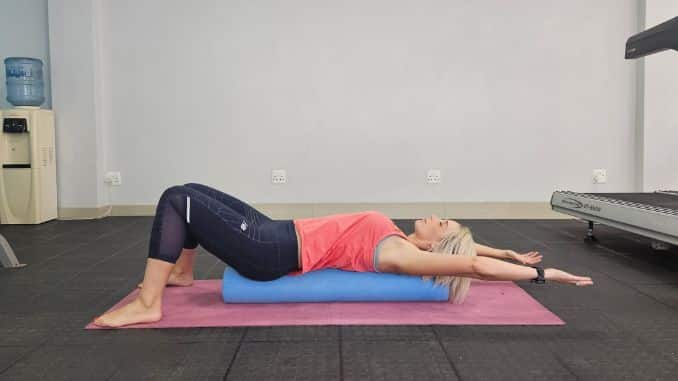 |
Variation 1
For this exercise, you may use two tennis balls for added pressure.
Begin in an upright standing position with your back against the wall and your feet shoulder-width apart. Step forward with both feet and place the tennis balls against the wall behind your back. Slightly bend your knees to move into a squat position, keeping your back flat against the wall. Find any painful spots on your midback and shoulder area, then press down and let the balls roll against the sore spots. Increase or decrease the pressure as needed. Repeat the movement.
 | 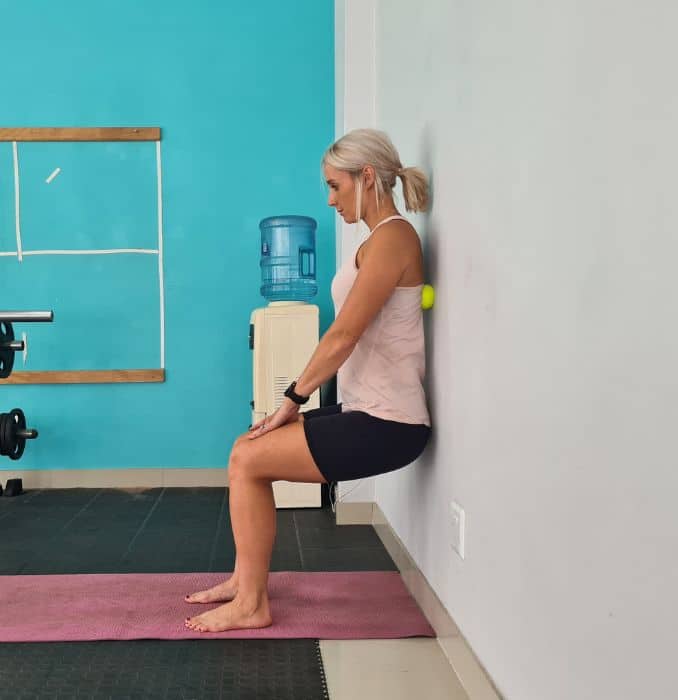 |
5. Breaths
Lie on your back on the floor with your knees bent and your feet flat on the floor. Place the foam roller vertically along your spine, with your head supported on one end of the roller and your seat on the opposite end of the roller. Maintain a good alignment with your head, shoulders, and hips as you keep your balance. Place your hands at your sides, relaxing your upper body. Close your eyes and take several deep belly breaths, in through your nose and out through your mouth. Complete 10 full belly breaths.
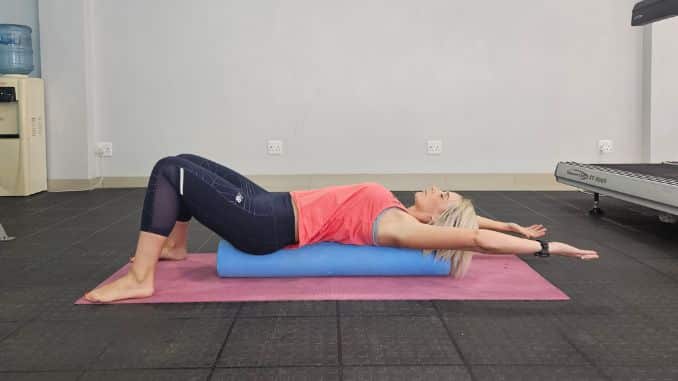
Variation Using A Tennis Ball
Lie on your back with your knees bent and feet flat on the floor. Place the tennis ball against your mid-back. Extend your hands out to your sides and relax your body. Close your eyes and take several deep belly breaths, in through your nose and out through your mouth. Complete 10 full belly breaths.
Other Myofascial Release Tools
Foam Roller
A cylindrical tool designed for self-myofascial release, foam rollers are available in various densities and lengths. They help to alleviate muscle tightness and improve flexibility by applying pressure to targeted areas.
Massage Balls
Massage balls vary in size and textures, offering a more focused and compact alternative to foam rollers. They are ideal for reaching specific trigger points and providing a deep tissue massage for myofascial release.
Massage Sticks
These handheld tools have a series of rolling or bumpy surfaces designed to target specific muscle groups. Massage sticks are effective for applying pressure and releasing tension along the length of muscles.
Grid Foam Roller
A variation of the traditional foam roller, the grid foam roller features a textured surface adorned with various patterns. This design helps to mimic the hands of a massage therapist and provides a more targeted myofascial release.
Massage Cane
Crafted in the shape of a cane and equipped with a variety of knobs and handles, massage canes are tailored to reaching and applying pressure to hard-to-reach areas. They are particularly useful for targeting the back and shoulders.
Massage Balls with Spikes
These massage balls have spikes or nodules on their surface, adding an extra layer of stimulation during myofascial release. The spikes help to increase blood flow and target specific areas with precision.
Conclusion
In conclusion, achieving myofascial release through tennis balls and other tools can be an effective and accessible way to alleviate tension and promote overall muscle health. The myofascial system, which includes muscles and the surrounding connective tissue (fascia), can become tight and restricted by various factors, including stress, poor posture, and overuse.
Tennis balls, lacrosse balls, foam rollers, and similar tools can specifically target areas of tension and trigger points, providing reassuring relief by helping to release tight fascia and improve flexibility. The pressure applied through these tools helps break up adhesions and knots, allowing the muscles to move more freely and reducing discomfort.
Consistent myofascial release practices can offer several benefits, including enhanced flexibility, better blood flow, and reduced muscle soreness. Incorporating these techniques into a well-rounded self-care routine, proper hydration, regular stretching, and adequate rest can enhance overall well-being and athletic performance.
Foam Rolling has become increasingly popular over the past few years. The foam roller is a versatile tool that allows you to massage deep into your muscles, providing relief from pain and tension.
Check out our Foam Rolling 101 just for you!

